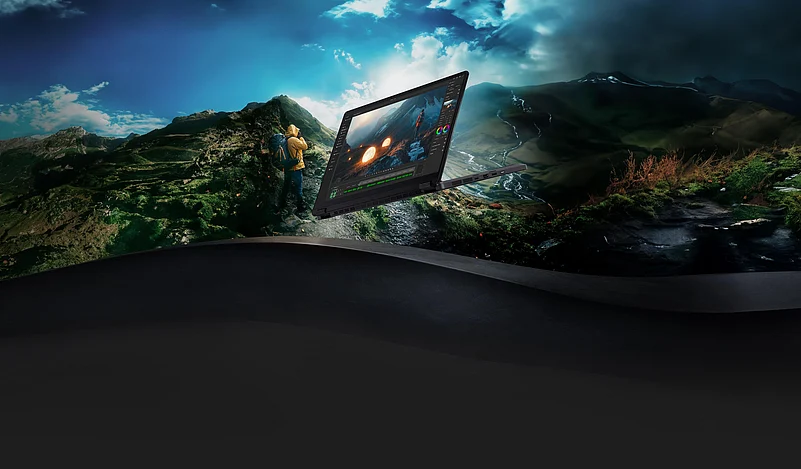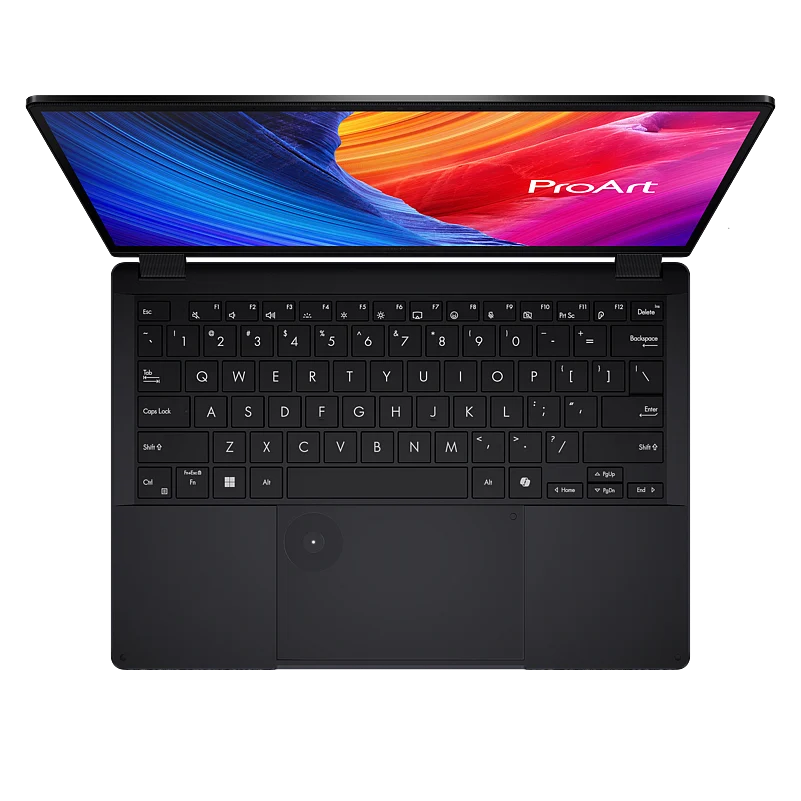Creators, watch out. There’s a new device eying for your hard-earned money. It’s a small laptop with a lot of potential. It’s compact and powerful. It’s just what the creators out there would want. It’s none other than the Asus ProArt PX13, a laptop aimed squarely at content creators.
The ProArt PX13 is one impressive convertible, touch-screen enabled, content creation device.
Built with creators in mind and a powerful set of internals, the ProArt PX13, turns out to be an impressive convertible, touch-screen-enabled, content creation device. Despite its compact form fact, the ProArt PX13 manages to fit in a 13.3-inch display. The outer casing, coloured in Nano Black, is designed to reduce reflections. It’s a sleek design on the whole, and the aluminium casing helps make the laptop feel solid and durable. The one downside is that the lid is a magnet for fingerprints. So, it has to be cleaned every so often.
Advertisement
Stacked laptop
The ProArt PX13 has the AMD Ryzen AI 9 HX 365 CPU, an NVIDIA GeForce RTX 4050 GPU, 24GB of RAM, 1TB SSD, and a 13.3-inch 3K OLED touchscreen display.
There’s a DC charging port, an HDMI port, a USB Type-C port, and a headphone jack on the left side. On the right side is another USB Type-C port, a USB Type-A port, a microSD card slot and the power button. There are vents for cooling on both sides.

That OLED display
Creators need a top-notch display for all their photo/video editing needs. Despite being limited to a 60Hz refresh rate, the ProArt PX13 features a bright and vivid OLED touch display. With a 3K resolution (2800x1800), the display shines through. OLEDs have vibrant colours and a crisp resolution which is good for creators. The downside of a 60Hz display is disappointing, but it is mitigated by the fact that creators are more likely than not, to be hooking up the laptop to an external display for the most part. The other downside is that the display doesn’t get very bright, hence, outdoor legibility could be a slight issue.
Advertisement
Performance
I was mostly glued to Adobe Photoshop and other editing tools during my few weeks, of testing this laptop. This was because this is a creator-first laptop and I wanted to push it toward that edge. The laptop ran beautifully and didn’t lag at all.
I also tested the laptop using DaVinci Resolve. The ProArt PX13 handled the power-hungry tasks with relative ease. 4K editing was a breeze on this laptop. This comes despite the GPU being underpowered compared to the CPU and RAM.
Yes, the ProArt PX13 isn’t a gaming laptop. It’s far from it. Despite that, I just had to test out some games on it. I installed my staple diet of Football Manager, F1 2024, Civilisation 6 and Halo Infinite. Predictably, with ray tracing enabled, the laptop struggles. Disable it and you’ll have a fun time playing most games. Halo Infinite was the only one that struggled on ultra settings. While the RTX 4050 was impressive, it was the 60Hz refresh rate which was a limitation.
Time to talk about the DialPad
If you’re new to Asus’ line of creative laptops, then you’re probably in for a shock when you open up the ProArt PX13. The DialPad, for those who don’t know, is a small touch-activated section of the touchpad. It’s essentially a contextual dial. It can control anything from media to your timelines on your video editing app. When I first came across the DialPad I wasn’t impressed. This time around, Asus has done some more work vis-a-vis the software and now it is a much more intuitive feature. You can program it for any create software suite that you prefer. If you don’t like the DialPad, then it is easy to deactivate.
Advertisement
To active the DialPad, all you need to do it touch the button in top-right corner and then swipe down diagonally. A small LED light will illuminate inside the DialPad to tell you that it is on. Go to the ‘Asus Dial & Control Panel’ app and you’ll be able to customisable it to the maximum. It works with several applications including DaVinci Resolve and Adobe Photoshop.
I’m not a content creator, and for me, it was an underutilised feature. But, yes, I can see the appeal for those who are.
Battery life: falls short of expectations
There’s a 73Wh battery including under-the-hood of the Asus ProArt PX13. While Intel and Qualcomm are openly competing on longer battery life, AMD seems to be proud of its performance in the new chip, and less so about its battery life.
Advertisement
Sadly, the ProArt PX13 lags in the battery department. I routinely got about 6-7 hours on a single charge, far below laptops with Qualcomm’s Snapdragon X Elite and Intel’s Lunar Lake. With an OLED display and a mid-to-high-range GPUs, the laptop isn’t expected to last long on a single charge. Still, with all the advancements in battery life, I expected a bit better.
If you keep brightness to 50 percent and stream 4K video, then you can expect it to last for about four hours at the max.
Asus Pen 2.0
The Asus Pen 2.0 may be thicker than before but it is very comfortable to hold. And the grip is fantastic. There are four interchangeable pen tips in the box, and there is also an included tip remover to easily swap between there. The Asus Pen 2.0 features two buttons on the front side, and a button on the back.
Advertisement
Each stroke glided across the screen and the cursor registers when you hover the Asus Pen just above the screen.

Keyboard and touchpad
The ProArt PX13 backlit keyboard is fantastic, the touchpad less so. There’s ample amount of space between each key and your fingers glide across the keyboard with relative ease. There’s a good amount of feedback as you press down (slightly harder than usual) on the keys. It’s a good amount of resistance and feels comfortable to type on.
The touchpad is large, but the click response was not satisfying.
What else?
- There is a FHD webcam that supports IR and, in turn, Windows Hello login. The camera quality, while not outstanding, was more than accurate for my various meetings. Colours were accurate and there was plenty of details
Advertisement
- There is no physical webcam shutter for all those worried about their privacy.
- The microphone was loud and clear.
- The speakers are located below the the laptop and near the front. The speakers can get loud, but can also distort at higher volumes. The clarity is good and I’ll happily listen to them on a daily basis, unless I’m watching an intense movie. One thing to note is that the bass is weak.
Verdict
Yes, the ProArt PX13 isn’t a perfect laptop. But, for creators, it is a very desirable product. It’s got a great build quality, an AMD Ryzen AI 9 365 CPU, Nvidia GPU, ample RAM and more. It’s also got no app compatibility issues.
The downside is that the display, despite being OLED is limited to a 60Hz refresh rate. There’s also the shorter battery life than other laptops on the market. The fans also get loud, but nothing that is a dealbreaker.
The ProArt PX13 will get all your creative work done without having to lug around a huge laptop. If you’re a creator, the ProArt PX13 definitely goes to the top of your shopping list. If you aren’t a creative, then you can consider another laptop with longer battery life.















 Just one email a week
Just one email a week